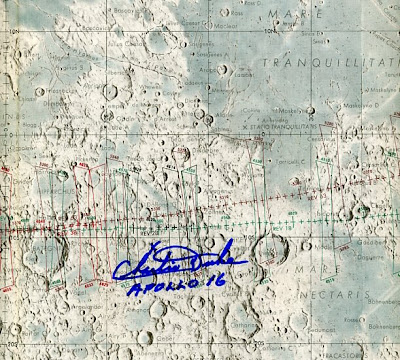Date: April 16-27, 1972
Crew:Commander John Young (41)
Command Module Pilot Thomas K. Mattingly (36)
Lunar Module Pilot Charles Duke (36)
Command Module Call Sign: Casper
Lunar Module Call Sign: Orion
Moon Landing Site: Descartes Mountains
Mission Distinctions: Fifth moon landing. Highest lunar landing elevation (25,688 feet), lunar speed record 11.2 MPH in rover.
 The CSM was named for the popular cartoon character, and referred to by the crew as their "friendly ghost."
The CSM was named for the popular cartoon character, and referred to by the crew as their "friendly ghost."The Apollo 16 suits were the first to have beverage assembly inside the space helmets, attached to 32-ounce bags of orange juice. Charlie Duke’s microphone got tangled in the straw tilt valve. and it released juice that drifted into his closed helmet in the weightlessness, coating his glasses as he was hovering the LM over the moon's surface. Later, Duke would joke that it was a "sticky moon landing."

Charlie Duke had exposed Ken Mattingly to the german measles two years before, forcing him to be scratched from the Apollo 13 crew only days before launch.
In 71 hours on the lunar surface, Young & Duke collected 245 pounds of moon material to be returned to Earth for study. Their specimens included a 25-pound chunk that was recorded as the largest single rock returned by the Apollo astronauts.
Scientific results caused planetary geologists to revise previous interpretations of the lunar highlands, concluding that meteorite impacts were the dominant agent in shaping the moon's ancient surfaces, not volcanic activity.

Apollo 16 Landing site map signed by Charlie Duke
Currently, the Apollo 16 Command Module Casper is on display at the US Space & Rocket Center (near "Space Camp") in Huntsville, Alabama.
The ascent stage of the Lunar Module Orion was jettisoned from the Command Module, but spun oddly out of control and orbited the moon for about a year before crashing to the moon; its exact impact site remains unknown. The descent stage is still on the Cayley Plains of the Descartes region.


































































